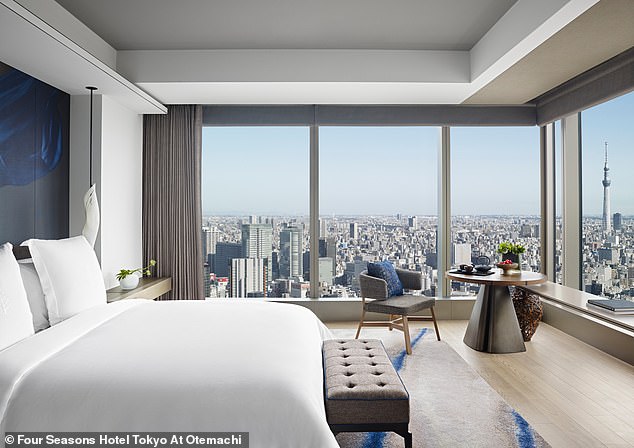“This morning you can see Mount Fuji,” comments a waiter as I look out the window during breakfast on a Saturday with especially clear skies.
These views are standard at the Four Seasons Hotel Tokyo At Otemachi.
Designed as a love letter to the Tokyo skyline, the 200 m (656 ft) tall hotel offers a new perspective of the world’s largest city through its floor-to-ceiling windows.
It’s not the tallest hotel in Tokyo, but it has a commanding presence with a 20m (66ft) pool, a Michelin-starred restaurant and one of the world’s best cocktail bars, each with panoramic windows that take advantage of the captivating urban landscape.
It occupies the highest floors (34-39) of the Otemachi One tower in Tokyo’s glittering Otemachi financial district.
Ailbhe MacMahon checked into the Four Seasons Hotel Tokyo in Otemachi. Above, panoramic views of the city from a Premier studio

The interior of the 190-room hotel was by designer Jean-Michel Gathy, who sought to merge Japan’s past and present in the project. Upstairs, the reception.
The hotel, opened in 2020, overlooks the Oriental Gardens of the Imperial Palace of the Emperor of Japana green view that greets you once the elevator doors open onto the 39th floor panoramic lobby.
The interior of the 190-room hotel was by designer Jean-Michel Gathy, who sought to fuse Japan’s past and present in the project, beginning with a vermilion-walled entrance inspired by the ‘torii’ gates of Shinto shrines.
Guests can take guided tours of the hotel’s private art collection: Yukiko Oshima’s rock installation in a shallow pond, reminiscent of Japanese Zen gardens, greets you at the reception, along with ink art by Nobuko Kawahara and elaborate works of Ikebana, the traditional Japanese temple. art of flower arrangement.
For those interested in studying more flowers, the hotel offers a shuttle service to popular cherry blossom spots in spring and can decorate rooms with fresh ‘sakura’ branches for 30,000 JPY (£158/$199) .
Not that the rooms need more adornment.

Ailbhe’s Deluxe Room, overlooking the Imperial Garden, features a “dreamy” moving fabric print

Above: A rock installation by artist Yukiko Oshima in the lobby area

The hotel’s entrance area, where guests take the elevator to the lobby located on the 39th floor.

The hotel occupies floors 34 to 39 of the Otemachi One tower.
An exercise in elegance, my luxury room It is adorned with Japanese ‘washi paper’ lanterns and a dreamlike moving fabric print by photographer Namiko Kitaura.
The blinds on the large windows open automatically when you open the door, creating more theater around the hotel’s stunning views.
This urban panorama also takes center stage in the Pignet restaurant.
It has a soaring outdoor terrace and a lunch and dinner menu that celebrates a different Italian region each month.
Breakfast is also served here, with a menu ranging from stuffed pancakes to a Japanese breakfast with rice, miso soup and fish (JPY 6,700/£35/$44 including buffet).
But the gastronomic jewel in the hotel’s crown has a Michelin star. Its Twhere French chef Guillaume Bracaval crafts smart French dishes using Japan’s rich larder: 95 percent of its ingredients are sustainably sourced from the island nation’s land and seas.

Pigneto Restaurant, upstairs, has a soaring outdoor terrace and a menu that celebrates an Italian region each month.

The Michelin-starred Est, where Ailbhe enjoyed a 10-course tasting menu of ‘master dishes’


Ailbhe enjoyed a cloud-shaped meringue dessert at Est, on the left, as well as the Jerusalem artichoke and caviar dish seen on the right.
Inspired by the 19th century Japanese movement, the space shines with gold leaf accents, while a wall of glass frames chefs at work in the kitchen.
There they prepare dish after masterful dish as part of the 10-course tasting menu (JPY30,000/£157/$199): smoked abalone cooked in butter and topped with cabbage leaves; Kombu slices to cleanse the palate; Jerusalem artichoke with walnuts, roasted and topped with caviar and dashi broth.
Desserts are from chef Michele Abbatemarco, who borrows from nature and the art world for his sweets: cloud-shaped meringue, followed by flower-shaped petit fours made with raw Japanese honey.
Sommelier Yuji Uesugi fills me in on the burgeoning Japanese wine scene as he pours Minaki sparkling sake and Tamba Sauvignon Blanc from Kyoto (JPY25,000/£131/$166 for wine pairing).
More unique drinks await you at the sensual Art Deco-style Virtù cocktail bar, officially The 20th best bar in Asia.
On recommendation, I try one of the bar’s most popular drinks, a smooth and sweet ‘Yuzu Nagi’ with yuzu gin (3,500 JPY/£18/$23).

Art Deco cocktail bar Virtù, pictured, is officially the 20th best bar in Asia.

The hotel spa features an elegant mirror-bottom pool.
Later, charismatic bartender Graham Kimura, who has tattoos of his favorite spirits, presents a stellar list of recommended bars in Tokyo, offering an insider’s look at the city’s world-famous nightlife scene.
Detoxification occurs through the hotel’s spa, with its relaxing ‘ofuro’ bath (a small, high-sided bathtub built for full-body immersion and relaxation), steam room and elegant mirror-bottom pool.
In a treatment room with even more panoramic views, I relax with a ‘Yakusugi’ (Japanese cedar) massage, which promises to offer the ‘serenity of a forest bath’ and help with jet lag.
When the treatment is finished, I can watch the sun set over the city. Anchored by distant Mount Fuji, Tokyo’s skyline is one of the best in the world, and it’s hard to think of a better place to admire it than here.

